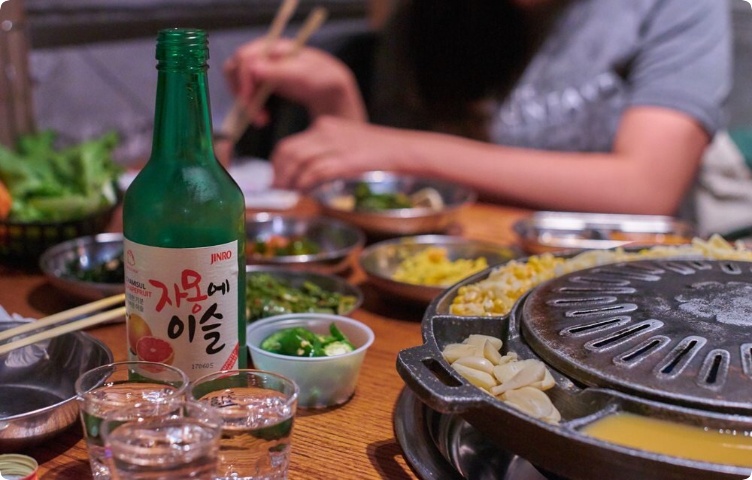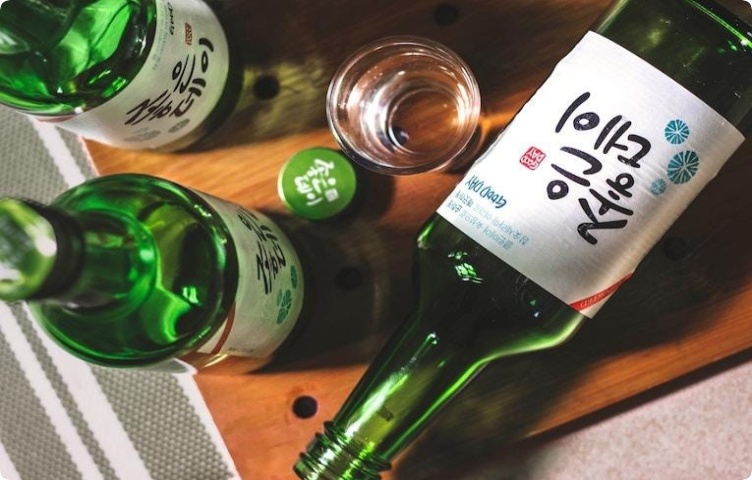For ten years now, Korean vodka made from fermented rice - soju - has been the leader in sales on the world alcohol market. Koreans themselves claim that their national product has the taste of life itself - sometimes bitter, sometimes sweet, and sometimes bland. If you have never tried this interesting drink, our article will introduce you to its features.
Drinking traditions in South Korea
The strength of Korean vodka is 20-40 degrees, so it is always consumed with meals. In the Korean language, there is a word "anju" which means food prepared specifically to be consumed with alcohol. Typically this includes fried meat with vegetables, grilled ribs, and in coastal areas, seafood and oysters. The main feature of soju is that it can be combined with many foods - pasta with meat sauce, fried rice, noodle soup. In Korea they say that meat warms the body, and soju cools it down.

In addition to appetizers, the traditions of serving the drink are important. Etiquette does not allow the participants of the feast to fill their glasses themselves. Soju is always drunk in company - with colleagues in a bar after work or with friends on a picnic. The senior participant in the feast pours the first glass and passes it to his neighbor at the table. He takes the vessel with both hands and turns his face to the side so as not to meet the gaze of the person who poured the soju. Making eye contact while drinking is considered tactless.
Then everyone drinks, trying not to empty the glasses to the bottom - this is considered impolite. As the meal progresses, guests are topped up with new portions. The drink can be sipped slowly, but more often it is drunk in one gulp.
Why is Soju so popular?
Gourmets prefer aromatic alcohol - whiskey, brandy, rum. Most types of vodka, including Korean, have no other aroma other than the smell of alcohol. But this has its own appeal - just drinking for pleasure, without analyzing the complex taste or bouquet of the drink.
Its popularity among guests is also explained by the active spread of South Korean culture. Films from this country and K-pop music arouse interest in the way of life of Koreans. In their series, they often show friends and family enjoying traditional alcohol in a cozy environment. Spectators from different countries involuntarily want to be in this warm atmosphere.
How is soju made?
Initially, Korean vodka was made exclusively from rice. In the 1950s, during the Korean War, the government banned the use of food-grade rice for alcohol production. Breeders began to use other types of raw materials - barley grain and wheat, tapioca, sweet potato.

The traditional method of preparing the drink consists of five steps:
- creating a starter from ground wheat with water;
- fermentation of the sourdough for three weeks;
- preparing puree from boiled rice and wheat sourdough;
- fermentation of puree for 12 days;
- straining and distillation.
Single distillation gives the alcohol a taste reminiscent of Japanese sake. Depending on the raw materials, the technology may change.
History of Soju
The drink has been produced in Korea since the 14th century, when it was conquered by Genghis Khan. The Mongols introduced the Arabic distillation method to the Koreans. Soon, several dozen distilleries producing rice vodka appeared near the then capital of Gegen. Half a century later, the Yuan dynasty, led by Kublai Khan, settled in Korea. The conquerors established a trading base in Andong. This prompted the expansion of soju production. Korean winemakers began trading with the Arabs and improved distillation technology. It is believed that this is when the traditional recipe for Korean vodka was born.
In the 20th century, the product began to be produced from starchy vegetables. Since 2015, famous Korean brands have been producing sparkling and fruity varieties of the drink.
What flavors of soju are there?
The alcohol content in different varieties ranges from 15 to 53 degrees. But most manufacturers stick to a strength of 20 degrees. Thanks to this, the product has a less harsh taste than vodka and is easier to drink. The texture of the drink is slightly viscous, which also improves taste perception.
A traditional variety made from rice, barley and wheat, it has a neutral taste with sweet notes. It is consumed in pure form or mixed with fruit juices.
Other flavors result from the use of additional ingredients, including:
sweet potatoes - have a more pronounced sweetness;
rice without the addition of other grains - the product produced from it has a milder taste;
fruit juices - the use of grape, apple, and peach juices gives the drink freshness and a sweet and sour taste.
-one">
Soju is often included in alcoholic cocktails, mixed with tonic, beer, syrups and even dairy products. Koreans themselves often dilute alcohol with orange, watermelon or melon juice.
Non-Korean soju
The national drink of Korea has gained such popularity abroad that Asian, European and American companies have mastered its production. There are known Chinese and Vietnamese varieties of soju that are not inferior in quality to Korean ones. The product is very popular in Canada, where it is produced by distilleries in Ontario. West 32 Soju and Tikki Soju are produced in the USA. The German company ISAE presents a premium variety of drink based on organic grain.
Soju: drinking culture
Most often, Korean vodka is consumed in its pure form, cooled to a temperature of +6-10° C. The traditional glassware for the drink is a low glass made of transparent glass, reminiscent of a vodka shot glass . Koreans like to mix medium-strength alcohol with port or light beer. The resulting mixture, called “somek,” is served with meat and vegetable dishes.

Premium varieties with an alcohol content of 40 proof pair well with Sprite, soda and lime juice. Korean youth prepare cocktails from a mixture of alcohol with the juice of apples, pears, and persimmons.
The neutral taste makes soju an excellent addition to savory snacks and meat dishes. Anju soju often includes fried chicken, barbecue, and seafood.
















































/https%3A%2F%2Fcomplexbar.com%2Fimages%2Fblog%2F245%2Fsojy_glavn.jpg)
/https%3A%2F%2Fcomplexbar.com%2Fimages%2Fblog%2F246%2Fsirop_scale_2400.jpeg)
/https%3A%2F%2Fcomplexbar.com%2Fimages%2Fblog%2F246%2Fkofe-vostochniy.jpg)
/https%3A%2F%2Fcomplexbar.com%2Fimages%2Fblog%2F245%2Fpexels-jason-villanueva-851555.jpg)
/https%3A%2F%2Fcomplexbar.com%2Fimages%2Fblog%2F246%2F2024-04-09_17.22.54.jpg)
/https%3A%2F%2Fcomplexbar.com%2Fimages%2Fblog%2F246%2F2024-04-09_17.22.47.jpg)
/https%3A%2F%2Fcomplexbar.com%2Fimages%2Fblog%2F246%2FCODE_anons_foamydrops_752%D1%85480_eng.jpg)
/https%3A%2F%2Fcomplexbar.com%2Fimages%2Fblog%2F246%2FAlina_752%D1%85480_eng.jpg)
/https%3A%2F%2Fcomplexbar.com%2Fimages%2Fblog%2F246%2F2024-04-09_17.23.22.jpg)
/https%3A%2F%2Fcomplexbar.com%2Fimages%2Fblog%2F246%2F2024-04-09_17.23.28.jpg)
/https%3A%2F%2Fcomplexbar.com%2Fimages%2Fblog%2F246%2F2024-04-09_17.23.35.jpg)
/https%3A%2F%2Fcomplexbar.com%2Fimages%2Fblog%2F246%2Fdrinksome_752%D1%85480_eng.jpg)
/https%3A%2F%2Fcomplexbar.com%2Fimages%2Fblog%2F246%2Fnude_752%D1%85480_eng.jpg)
/https%3A%2F%2Fcomplexbar.com%2Fimages%2Fblog%2F246%2F752%D1%85480_eng__1_.jpg)
/https%3A%2F%2Fcomplexbar.com%2Fimages%2Fblog%2F246%2F752%D1%85480_eng.jpg)
/https%3A%2F%2Fcomplexbar.com%2Fimages%2Fblog%2F246%2FStudioRaw_752%D1%85480_eng.jpg)
/https%3A%2F%2Fcomplexbar.com%2Fimages%2Fblog%2F246%2FDoppio_tea_752%D1%85480_eng.jpg)
/https%3A%2F%2Fcomplexbar.com%2Fimages%2Fblog%2F246%2FTognana_Stars_Stripes_752%D1%85480_eng.jpg)
/https%3A%2F%2Fcomplexbar.com%2Fimages%2Fblog%2F246%2FRona_752%D1%85480_eng.jpg)
/https%3A%2F%2Fcomplexbar.com%2Fimages%2Fblog%2F246%2FDoppio_vending_752%D1%85480_eng.jpg)
/https%3A%2F%2Fcomplexbar.com%2Fimages%2Fblog%2F246%2FEssence_sukhie_smesi_752%D1%85480_eng.jpg)
/https%3A%2F%2Fcomplexbar.com%2Fimages%2Fblog%2F246%2FODK_sukhie_smesi752%D1%85480_eng.jpg)
/https%3A%2F%2Fcomplexbar.com%2Fimages%2Fblog%2F246%2Funiforma-barmena.jpg)
/https%3A%2F%2Fcomplexbar.com%2Fimages%2Fblog%2F246%2Fkak-nanyat-barmena.jpg)
/https%3A%2F%2Fcomplexbar.com%2Fimages%2Fblog%2F246%2Fsirop_scale_2400.jpeg)
/https%3A%2F%2Fcomplexbar.com%2Fimages%2Fblog%2F246%2FPeugeot_Anons_Paris_U%27Select_Line_Daman_752%D1%85480_eng.jpg)
/https%3A%2F%2Fcomplexbar.com%2Fimages%2Fblog%2F246%2Fkofe-vostochniy.jpg)
/https%3A%2F%2Fcomplexbar.com%2Fimages%2Fblog%2F246%2FMadler.jpg)
/https%3A%2F%2Fcomplexbar.com%2Fimages%2Fblog%2F246%2Fprofbartender_glavn.jpeg)